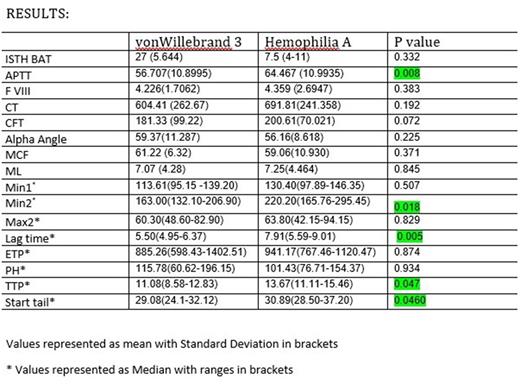Abstract
Introduction: Von Willebrand disease (VWD) is the most common inherited bleeding disorder. Type 3 VWD is the most severe form of this disease with a prevalence of about 0.5 to 1 per million in Western countries but is much more common in communities with high levels of consanguinity like South India. Type 3 VWD is characterised by undetectable Von Willebrand Factor and reduced Factor VIII levels. (1,2)
Global hemostasis assays clot waveform analysis (CWA) [3,4] and thrombin generation test (TGT)[5,6] reflect the entire process of thrombin generation, and thus reflect the actual bleeding severity . Rotational Thromboelastogram (ROTEM) demonstrates the dynamics of clot formation over time.
Global Hemostasis Assays is extensively studied in Hemophilia A(HA) patients, however there are very few studies which analysed the same in type 3 VWD in account of rarity of disease
Our aim was to study ROTEM, TGT and APTT-CWA parameters in cases of vWD 3. We also aimed to compare global hemostasis parameters in vWD3 to those in mild to moderate hemophilia A with similar levels of Factor VIII.
Materials and Methods:
Retrospective study for a period of 2 years which included 27 cases of vWD3 (with undetectable vWF antigen) and 34 cases of Hemophilia A- 25 moderate and 9 mild deficiency (F VIII-5-10%). Complete coagulation workup was done which included International Society of Thrombosis and Hemostasis based Bleeding Assessment Tool(BAT) Score questionnaire, Bleeding time, Platelet Function Analyser 200, Prothrombin Time(PT), APTT, Ristocetin Cofactor, Von Willebrand Antigen, Factor assays, Ristocetin induced platelet aggregation and Global Hemostasis Assays-ROTEM, TGT and CWA.
BAT score was done to assess severity of bleeding. TGT was performed by Calibrated Automated Thrombogram, CWA by photo-optical coagulometer and factor levels by one stage clot-based assays on ACL Top 750. Rotem was performed in whole blood by modified extem. TGT was could be done only on 16/34 Hemophilia A cases and 14/27 vWD3 cases.
Statistical Analysis:
For continuous data, the descriptive statistics mean, SD, and for non-normally distributed data median, IQR were done. Based on the normality of data, the parametric t-test or non-parametric Mann Whitney test was used to find the difference between groups. All tests were two-sided at alpha () =0.05 level of significance. All the statistical analysis was performed using Statistical Package for Social sciences (SPSS) version 21.0.
Results:
Results are summarized in Table 1
Global hemostasis tests in vWD3
A.1)ROTEM- CT (Clotting Time) was prolonged in 44% cases, 55 % cases it was within normal range and shortened in rest.
CFT (Clot Formation Time) and alpha angle were within normal range in 81.1% cases, prolonged in 0.3% cases and shortened in rest.
MCF (Maximum Clot Firmness) was reduced in 2 cases, and normal in remaining cases.
ML(Maximum Lysis) was within range for all cases.
A.2) APTT CWA- Min1 was decreased in 25.9 % cases, rest 74% had within normal range.
Min2 was decreased in 96% cases. Max 2 was decreased in all cases.
A.3) TGT- Lag time was prolonged in 13/14 (93%) cases. ETP was increased in 7/14 cases (50%). Peak height was decreased in all cases. TTP was prolonged in 13/14 cases (93%). Start tail was prolonged in 12/14 cases.
B) Comparison between vWD3 and Mild to Moderate Hemophilia
Refer to table -1
APTT was significantly prolonged (P value 0.008) in HA group than vWD3, though Factor VIII was similar in both groups.
CWA were comparable to HA cases. Min 2 was statistically lower in vWD3 compared to HA group between the 2 groups (P value- 0.018)
ROTEM were comparable between the 2 groups.
In TGT, the median lag time (min)was significantly more prolonged in vWD3 with median of 5.50(4.95-6.37) than Hemophilia A patients as seen with APTT. ETP and Peak Thrombin were not significantly different between the 2 groups. Time to peak and start tail were statistically lower among cases of vWD 3 and haemophilia A, p value being <0.05.
CONCLUSION: Global hemostasis test in von Willebrand disease showed a hypocoagulable state in Thrombin Generation Tests and APTT CWA. ROTEM didn't show any significant change despite Factor VIII levels being low
Tests which measure Factor VIII assay and tests which reflect Factor VIII activity as in global hemostasis assay do not show significant difference in patients who have low Factor VIII level irrespective of the diagnosis being von Willebrand disease or Hemophilia A.
Disclosures
No relevant conflicts of interest to declare.
Author notes
Asterisk with author names denotes non-ASH members.


This feature is available to Subscribers Only
Sign In or Create an Account Close Modal